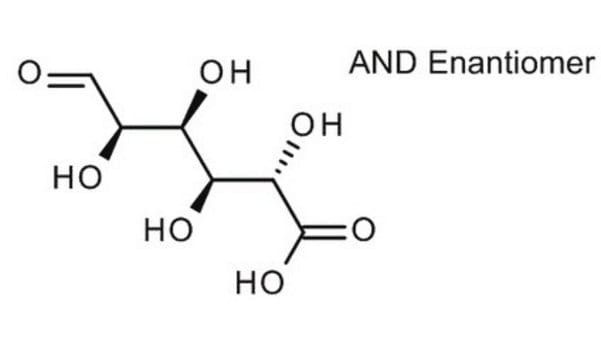This product is prepared from the Gluconic acid and not a potassium or sodium salt form. While trace analysis testing is not performed on this material, no potassium or sodium has been added during the manufacturing process.
G1951
D-Gluconic acid solution
49-53 wt. % in H2O
Sinonimo/i:
2,3,4,5,6-Pentahydroxycaproic acid
Scegli un formato
Scegli un formato
About This Item
Prodotti consigliati
Stato
viscous liquid
Livello qualitativo
Attività ottica
[α]/D +9.0 to 15.5°
Concentrazione
49-53 wt. % in H2O
Indice di rifrazione
n20/D 1.4161
Densità
1.234 g/mL at 25 °C
Stringa SMILE
OC[C@@H](O)[C@@H](O)[C@H](O)[C@@H](O)C(O)=O
InChI
1S/C6H12O7/c7-1-2(8)3(9)4(10)5(11)6(12)13/h2-5,7-11H,1H2,(H,12,13)/t2-,3-,4+,5-/m1/s1
RGHNJXZEOKUKBD-SQOUGZDYSA-N
Cerchi prodotti simili? Visita Guida al confronto tra prodotti
Applicazioni
used in hygienic products, food and pharmaceutical industry.[2]
Codice della classe di stoccaggio
10 - Combustible liquids
Classe di pericolosità dell'acqua (WGK)
WGK 1
Punto d’infiammabilità (°F)
Not applicable
Punto d’infiammabilità (°C)
Not applicable
Dispositivi di protezione individuale
Faceshields, Gloves, Goggles, type ABEK (EN14387) respirator filter
Scegli una delle versioni più recenti:
Possiedi già questo prodotto?
I documenti relativi ai prodotti acquistati recentemente sono disponibili nell’Archivio dei documenti.
I clienti hanno visto anche
-
Does this product contain potassium or sodium as a component?
1 risposta-
Utile?
-
-
How is shipping temperature determined? And how is it related to the product storage temperature?
1 risposta-
Products may be shipped at a different temperature than the recommended long-term storage temperature. If the product quality is sensitive to short-term exposure to conditions other than the recommended long-term storage, it will be shipped on wet or dry-ice. If the product quality is NOT affected by short-term exposure to conditions other than the recommended long-term storage, it will be shipped at ambient temperature. As shipping routes are configured for minimum transit times, shipping at ambient temperature helps control shipping costs for our customers. For more information, please refer to the Storage and Transport Conditions document: https://www.sigmaaldrich.com/deepweb/assets/sigmaaldrich/marketing/global/documents/316/622/storage-transport-conditions-mk.pdf
Utile?
-
-
How can I determine the shelf life / expiration / retest date of this product?
1 risposta-
If this product has an expiration or retest date, it will be shown on the Certificate of Analysis (COA, CofA). If there is no retest or expiration date listed on the product's COA, we do not have suitable stability data to determine a shelf life. For these products, the only date on the COA will be the release date; a retest, expiration, or use-by-date will not be displayed.
For all products, we recommend handling per defined conditions as printed in our product literature and website product descriptions. We recommend that products should be routinely inspected by customers to ensure they perform as expected.
For products without retest or expiration dates, our standard warranty of 1 year from the date of shipment is applicable.
For more information, please refer to the Product Dating Information document: https://www.sigmaaldrich.com/deepweb/assets/sigmaaldrich/marketing/global/documents/449/386/product-dating-information-mk.pdfUtile?
-
-
WHAT is the ppm of the solution in 100ml
1 risposta-
The concentration of this product may range from 49% - 53%. The calculated ppm value will range from 490,000 - 530,000.
Utile?
-
-
Hi what is the molarity of the solution provided? 25g in 50%wt solution
1 risposta-
At exactly 50% the molarity of this solution is 3.14M. The molarity may be calculated using the following equation below:
Molarity (moles/L) = Density (g/L) ÷ Molecular Weight (g/mol) * purity
= 1234g/L ÷ 196.16 g/mol * 0.50
= 3.14539MThe concentration of this product ranges from 49 - 53% and may change slightly from lot to lot. Please see the link below to access a sample or specific lot Certificate of Analysis:
https://www.sigmaaldrich.com/product/aldrich/g1951#product-documentationUtile?
-
Filtri attivi
Il team dei nostri ricercatori vanta grande esperienza in tutte le aree della ricerca quali Life Science, scienza dei materiali, sintesi chimica, cromatografia, discipline analitiche, ecc..
Contatta l'Assistenza Tecnica.











